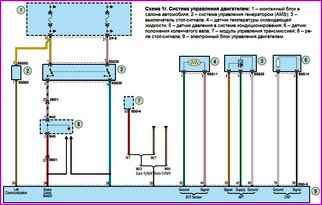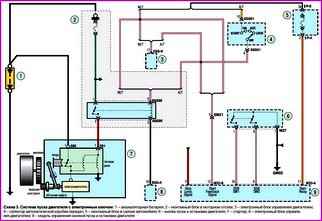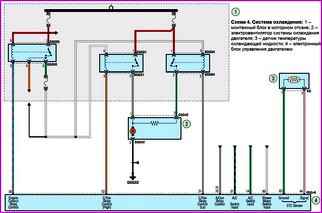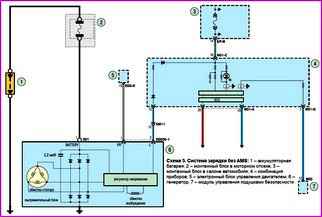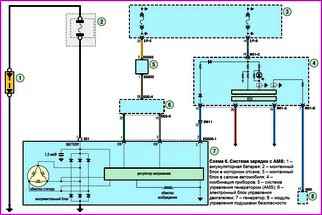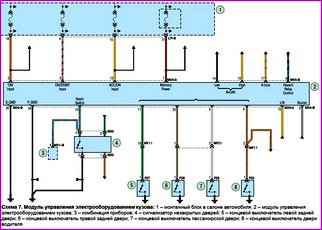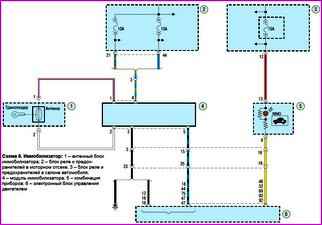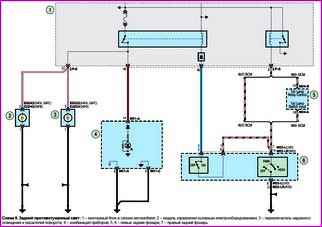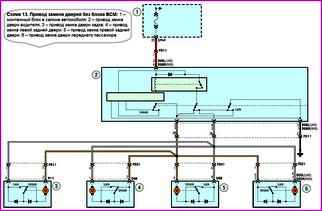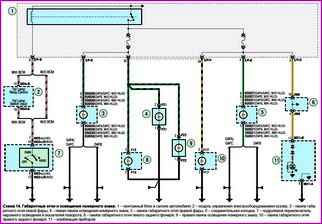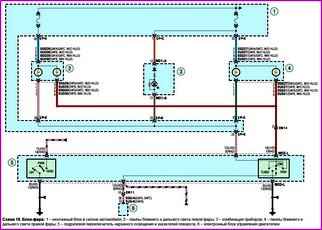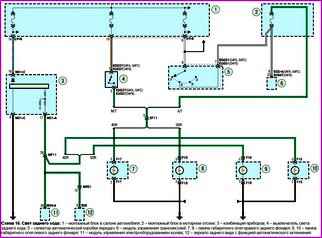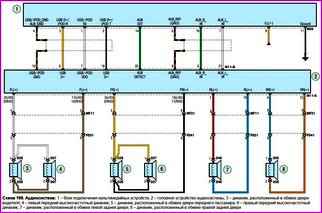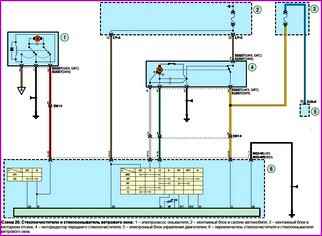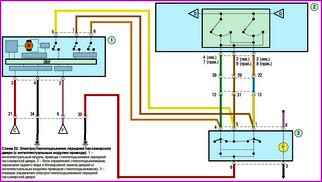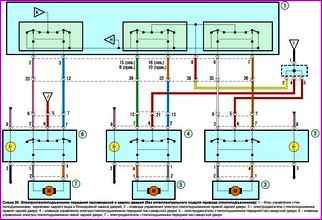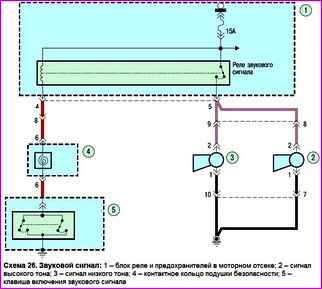In the article, we will consider the features of the car's electrics and give schematic diagrams
The electrical equipment of the car is traditionally made according to a single-wire circuit
The function of the second wire is performed by the car body.
The electrical circuits of the engine control system are made according to a multi-wire circuit and are connected to the car's ground only through the electronic control unit.
Consumers are powered by a battery (when the engine is not running) and a generator (when the engine is running).
To switch the main circuits of the car, a combined ignition switch (lock) is used, consisting of a contact part and a mechanical anti-theft device with a lock.


Depending on the configuration, a button to start and stop the engine is installed to switch the main circuits of the car.
A feature of the Hyundai Solaris electrical system is the use of CAN (Controller Area Network) multiplex buses for data transmission.
Each multiplex bus is a twisted pair of wires connecting electronic control units.
CAN buses are connected to each other via a gateway.
The use of multiplex CAN buses provides high data transfer rates (up to 1 Mbps) and can significantly reduce the number of wires in the car.
The diagnostic CAN bus is connected to the diagnostic connector located in the passenger compartment.

When a malfunction occurs in the CAN bus, the ECUs connected to it at that moment store a fault code in memory. This code and other fault codes stored in the memory of electronic units can be read by connecting a scanning device to the diagnostic connector.
The electronic control unit for the electrical equipment of the body allows you to delay the switching on and off of electrical devices, as well as change the duration of the pause in their work, depending on the selected control algorithm.
Carry out any work on the electrical equipment of the car only with the battery disconnected.
Disconnect or connect the battery only when the ignition is off.
When checking the circuits of electrical equipment, it is forbidden to short the wires to ground (check the health of the circuits "for a spark"), as this can lead to failure of electrical equipment elements.
It is forbidden to use fuses that are not provided for by the design of the car or designed for a higher current, and also to use wire instead of fuses.
When replacing fuses, do not use screwdrivers, as this can lead to a short circuit in electrical circuits.
It is forbidden to disconnect the battery while the engine is running in order to avoid damage to the voltage regulator and elements of the car's electronic equipment.
When carrying out electric welding work on a car, it is necessary to disconnect the wires from the battery terminals, the generator and the electronic engine control unit.
Regularly clean the battery terminals and cable lugs from oxides and dirt.
When recharging the battery with a charger, disconnect the wires from the battery terminals.
A typical electrical circuit may include a main electrical element, various switches, relays, electric motors, fuses, fuses or circuit breakers related to this element, wiring and connectors used to connect the main element to the battery and ground body.
Before you begin troubleshooting any electrical circuit, carefully study the relevant diagram to understand its function as clearly as possible.
The circle of troubleshooting is usually narrowed by gradually identifying and eliminating normally functioning elements of the same circuit.
If several elements or circuits fail at the same time, the most likely cause of the failure is a blown fuse or a broken contact with the "ground" (different circuits in many cases can be closed to one fuse or ground terminal).
Electrical equipment failures are often due to the simplest causes, such as corrosion of connector contacts, fuse failure, fuse blown, or relay damage.
Visually check the condition of all fuses, wiring, and connectors in the circuit before proceeding to a more detailed check of the health of its components.
When using diagnostic tools for troubleshooting, carefully plan (in accordance with the attached electrical diagrams) where and in what sequence the device should be connected in the loop for the most effective troubleshooting.
The main diagnostic tools include an electrical circuit tester or voltmeter (you can also use a 12-volt test lamp with a set of connecting wires), an open circuit indicator (probe) that turns on the lamp, its own power supply and a set of connecting wires.
In addition, you should always have a set of wires in the car for starting the engine from an external source (the battery of another car), equipped with crocodile clips and preferably an electrical circuit breaker.
They can be used for shunting and connecting various elements of electrical equipment when diagnosing a circuit.
As already mentioned, before starting to check the circuit using diagnostic equipment, determine the connection points from the diagrams.
Checks for the presence of supply voltage are carried out in case of an electrical circuit failure.
Connect one of the circuit tester wires to the negative battery terminal, or make good contact with the vehicle body.
Connect the other tester lead to the terminal of the circuit being tested, preferably closest to the battery or fuse.
If the tester's control lamp lights up, there is supply voltage on this section of the circuit, which confirms the health of the circuit between this point of the circuit and the battery.
In the same way, explore the rest of the chain.
Detection of a supply voltage failure indicates the presence of a fault between this point in the circuit and the last one previously checked (where the supply voltage was).
In most cases, the cause of failure is loosening of the connectors and damage to the contacts themselves (oxidation).
Looking for a short circuit
One of the methods for finding a short circuit is to remove the fuse and connect a probe lamp or voltmeter instead.
There must be no voltage in the circuit. Pull the wiring while watching the probe lamp.
If the lamp starts flashing, there is a short to ground somewhere in this wiring harness, possibly caused by chafing of the wire insulation.
A similar test can be carried out for each of the components of the electrical circuit by turning on the appropriate switches.
Checking the reliability of contact with the "mass".
Disconnect the battery and connect one of the wires of a probe lamp with an independent power source to a point with known good contact with ground.
Connect the other lamp wire to the wire harness or connector pin you are testing. If the lamp lights up, ground contact is OK (and vice versa).
A check for the absence of a break is carried out for detected ia breaks in the electrical circuit.
After disconnecting power to the circuit, test it with a self-powered test lamp.
Connect the probe leads to both ends of the circuit. If the control lamp lights up, there is no open circuit.
If the lamp does not light up, then this indicates an open circuit in the circuit.
Similarly, you can check the health of the switch by connecting the probe to its contacts.
When the switch is turned to the "ON" position, the probe lamp should light up.
Localize the breakpoint
When diagnosing an open section of an electrical circuit, it is quite difficult to visually detect the cause of the malfunction, since it can be difficult to visually check the terminals for corrosion or a deterioration in the quality of their contacts due to limited access to them (usually the terminals are closed by the contact connector housing) .
A sharp twitch of the body of the wiring harness block on the sensor or the wiring harness itself in many cases leads to contact restoration.
Keep this in mind when trying to isolate the cause of a circuit failure that is suspected to be open.
Unstable failures may be due to oxidation of the terminals or poor quality of the contacts.
Diagnosing faults in electrical circuits is not a difficult task, provided it is clear that electric current is supplied to all consumers (lamp, electric motor, etc.) from the battery through wires through switches, relays, fuses, fuses, and then returns to the battery through the "mass" (body) of the car.
Any problems related to the failure of electrical equipment can be caused by the interruption of the supply of electricity to them from the battery or the return of current to the battery.










